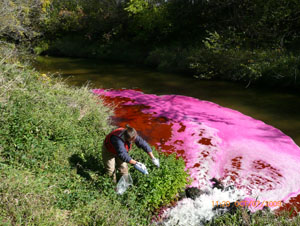Project Title: Endocrine active chemicals/pharmaceuticals in Minnesota wastewaters and surface waters
Project Number: 8607DYA - MN 260
Project Chief: Lee, Kathy
Project Start Date: September 2009
Project End Date: December 2010
Cooperators: Minnesota Pollution Control Agency
Project Collaborators: St. Cloud State University, St. Thomas University
Publication: USGS Data Series 575
Project Website

Objectives:
The USGS in collaboration with the Minnesota Pollution Control Agency, Saint Cloud State University, University of St. Thomas, and the University of Colorado collaborated on this study to determine the occurrence of EACs and pharmaceuticals in water samples collected from the effluents from 25 WWTPs and at sites upstream and downstream of WWTP effluent discharge in Minnesota during September-November 2009. The second objective is to measure concentrations of EACs and pharmaceuticals in bottom sediments collected upstream and downstream of effluent discharges, and the third objective is to estimate estrogenicty of water samples using an in-vitro bioassay, and concentrations of plasma vitellogenin and other sex characteristics of caged fish from onsite exposure experiments.
Progress during FY10
Pharmaceuticals and endocrine active chemicals enter surface waters from a variety of point and non-point sources including wastewater treatment plant (WWTP) discharges, land application of biosolids, and agriculture. These chemicals are widely used in domestic, commercial, and agricultural practices, and they are commonly detected in surface waters. To evaluate the relative effect of WWTP effluent loading relative to non-point sources, a statewide study was conducted by comparing 24 stream reaches in 20 watersheds of differing environmental settings. Each field site consisted of a location upstream of the WWTP discharge, the WWTP effluent, and downstream of the WWTP discharge. Water samples were analyzed for a suite of water quality constituents, trace elements, alkylphenolic endocrine disrupting chemicals, and steroidal hormones. Pharmaceuticals detected include carbamazepine (anticonvulsant), diphenhydramine (antihistamine), trimethoprim and sulfamethoxazole (antibiotics), diltiazem (heart arrhythmia medication), caffeine (stimulant), codeine, cotinine (nicotine metabolite), and 1, 7-dimethylxanthine (caffeine metabolite). The concentrations were generally low (less than 1 microgram per liter) and generally occurred as mixtures. More pharmaceuticals were detected in WWTP effluent samples than in samples collected downstream of effluent and stream samples collected upstream of effluent. Alkylphenols (4 nonylphenol, 4-nonylphenolethoxylates, 4-t-octylphenol and 4-t-octylphenolethoxylates) plastic components (BPA), and steroid hormones were also widely distributed in WWTP effluent and surface waters. In general, the upstream concentrations were lower than those in the WWTP effluent. At several sites, upstream and downstream concentrations of pharmaceuticals, alkylphenolic compounds or steroidal hormones were greater than concentrations in the WWTP effluent, potentially indicating other landscape-based sources. Bottom sediments are an important potential storage area for organic chemicals in aquatic ecosystems. Preliminary results suggest that the bottom sediments in the rivers contain numerous chemicals including endocrine active chemicals.
Progress for FY11
The results of this study have been published and can be viewed from the USGS Pubs Warehouse.
| 
